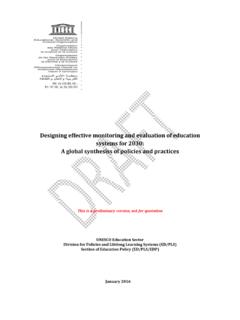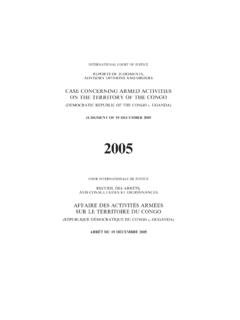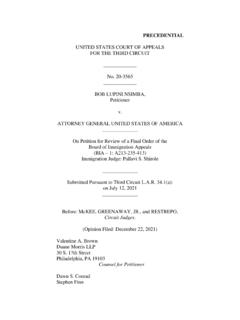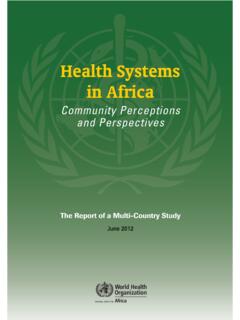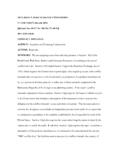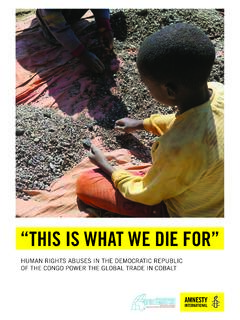Transcription of Supply Chain of Raw Materials Used in the Manufacturing of ...
1 Supply Chain OF RAW. Materials USED IN THE. Manufacturing OF. LIGHT-DUTY VEHICLE. LITHIUM-ION BATTERIES. Tsisilile Igogo, Debra Sandor, Ahmad Mayyas, and Jill Engel-Cox Clean Energy Manufacturing Analysis Center National Renewable Energy Laboratory CEMAC is operated by the Joint Institute for Strategic Energy Analysis for the Department of Energy's Clean Energy Manufacturing Initiative. Technical Report NREL/TP-6A20-73374. August 2019. Contract No. DE-AC36-08GO28308. Supply Chain OF RAW. Materials USED IN. THE Manufacturing . OF LIGHT-DUTY VEHICLE. LITHIUM-ION BATTERIES. Tsisilile Igogo, Debra Sandor, Ahmad Mayyas, and Jill Engel-Cox Clean Energy Manufacturing Analysis Center National Renewable Energy Laboratory CEMAC is operated by the Joint Institute for Strategic Energy Analysis for the Department of Energy's Clean Energy Manufacturing Initiative. Clean Energy Manufacturing Technical Report Analysis Center NREL/TP-6A20-73374. August 2019. 15013 Denver West Parkway Contract No.
2 DE-AC36-08GO28308. Golden, CO 80401. 303-275-3000. NOTICE. This work was authored by the National Renewable Energy Laboratory, operated by Alliance for Sustainable Energy, LLC, for the Department of Energy (DOE) under Contract No. DE-AC36- 08GO28308. Funding provided by Department of Energy Office of Energy Efficiency and Renewable Energy Strategic Programs, Policy and Analysis Office. The views expressed herein do not necessarily represent the views of the DOE or the Government. This report is available at no cost from the National Renewable Energy Laboratory (NREL) at Department of Energy (DOE) reports produced after 1991 and a growing number of pre-1991. documents are available free via Cover Photos: (left to right) iStock 2225189; iStock 16687273; Oak Ridge National Laboratory; iStock 24304597; iStock 26005993;. iStock 2069560. NREL prints on paper that contains recycled content. ii This report is available at no cost from the National Renewable Energy Laboratory (NREL) at Preface This report aims to integrate raw Materials into the Clean Energy Manufacturing Analysis Center (CEMAC) Benchmark framework.
3 Benchmarking raw Materials provides a broader view of the Supply Chain of clean energy technologies, from the mines to the manufacturer. This report provides insight into resource location and ownership, global production, demand, and trade, highlighting potential Supply Chain risks and opportunities. The report focuses on the lithium and cobalt Supply chains. It serves as a foundation for incorporating the raw Materials link for other clean energy technologies into future CEMAC Benchmark reports. iii This report is available at no cost from the National Renewable Energy Laboratory (NREL) at Acknowledgments We would like to thank Allison Anderson Book and Ben Mandler from American Geosciences Institute for their support in developing this topic and providing information that enabled this report. We also thank Kim Shedd and Brian Jaskula, Geological Survey cobalt and lithium experts, for sharing their insight on data. Finally, would like to thank all of the National Renewable Energy Laboratory and American Geosciences Institute employees who contributed to the success of this report.
4 Iv This report is available at no cost from the National Renewable Energy Laboratory (NREL) at List of Acronyms DRC democratic republic of congo HS Harmonized System LCE lithium carbonate equivalent LDV light-duty electric vehicle Li lithium Li-ion lithium-ion LIB lithium-ion battery mt metric tons MWh megawatt-hour NCA nickel cobalt aluminum NMC nickel manganese cobalt NREL National Renewable Energy Laboratory ROW rest of world USGS United States Geological Survey WCO World Customs Organization IEA International Energy Agency UN United Nations CEMAC Clean Energy Manufacturing Analysis Center v This report is available at no cost from the National Renewable Energy Laboratory (NREL) at Executive Summary When assessing the value and potential risks to Manufacturing Supply chains for clean technologies, data for upstream raw Materials has been confounded with data for larger Materials markets and is therefore difficult to differentiate. The report lays the foundation for integrating raw Materials into technology Supply Chain analysis by looking at cobalt and lithium.
5 Two key raw Materials used to manufacture cathode sheets and electrolytes the subcomponents of light-duty vehicle (LDV) lithium-ion (Li-ion) battery cells from 2014 through 2016. Both cobalt and lithium are highly concentrated in a few countries. For example, from 2014. through 2016, an average of 53% of global mined cobalt production came from the democratic republic of congo (DRC), while an average of 47% of global cobalt refining took place in China (USGS 2018; Cobalt Institute 2018). Additionally, more than 80% of global lithium production comes from Australia, Chile, and Argentina, while more than 60% of manganese is mined in South Africa, China, and Australia (USGS 2018). Due to high geographic concentration in production, the markets for most of these Materials are generally less transparent than those for conventional Materials like aluminum and copper. These Materials are also used in other industries, but as electric vehicle deployments increase, battery production is becoming an increasingly important source of demand.
6 Understanding these Materials ' markets is therefore critical to understanding the impacts of continued LDV development on mineral production, and vice versa. This analysis suggests that the cobalt Supply Chain is relatively less secure than the lithium Supply Chain . Between 2014 and 2016, in addition to demand shocks generated by economic slowdown, cobalt production was also affected by price volatility in other metal markets. Cobalt is mainly produced as a byproduct or coproduct of copper and nickel, both of which have volatile markets. Cobalt Supply responded strongly to the sharp drop in base metal prices during this period. We also find that most leading producers of cathode active Materials are highly involved throughout the raw material value Chain in some capacity. As for the lithium market, although Australia owns about 47% of global lithium reserves and accounts for an average of 41% of global lithium production, China accounts for 47% of lithium carbonate refinery capacity, mostly because it processes the vast majority of Australian lithium.
7 China also leads in demand of cobalt and lithium for LDV Li-ion battery (LIB) Materials . Its estimated use from 2014 through 2016 was between 15,000 metric tons (mt) and 24,000 mt of cobalt, and between 15,000 Mt and 40,000. Mt of lithium carbonate equivalent. Other top markets for cobalt and lithium for LDV LIB. Materials include Japan, South Korea, and Belgium. As for trade, the democratic republic of congo is the leading exporter of cobalt Materials , with about $ billion worth of cobalt Materials exported from 2014 through 2016. China is the leading importer of cobalt Materials , with about $ billion worth of cobalt Materials imported in the same period. Of the lithium Materials analyzed in this report (lithium carbonate and hydroxide), Chile leads on exports, with about $151 million worth of lithium exported from 2014. through 2016, whereas Japan leads on imports, reporting about $478 million worth of imported vi This report is available at no cost from the National Renewable Energy Laboratory (NREL) at lithium Materials .
8 Lithium trade flow records for Australia are not tracked separately by the Harmonized System (HS) code. Australia exports most of its unprocessed lithium (spodumene). ore to China. The analysis described in this report is limited to lithium Materials tracked by the HS code and used in LDVs. vii This report is available at no cost from the National Renewable Energy Laboratory (NREL) at Table of Contents 1 Introduction .. 1. Location of Key Raw 1. LDV Materials Use .. 2. 2 Cobalt Market .. 3. Cobalt Supply for All Applications .. 3. Cobalt Demand .. 5. Demand for All 5. Cobalt Demand for Manufacturing of LDV Li-ion Batteries .. 5. Cobalt Trade 6. 3 Lithium 8. Lithium Supply for All Applications .. 8. Lithium 9. Demand for All 9. Lithium Demand for Manufacturing of LDV Li-ion 10. Lithium Trade Flows .. 11. 4 Conclusion .. 13. References .. 14. viii This report is available at no cost from the National Renewable Energy Laboratory (NREL) at List of Figures Figure 1.
9 Key nickel, manganese, cobalt (NMC) Materials locations .. 1. Figure 2. Cobalt Supply Chain in LIB Manufacturing .. 3. Figure 3. Cobalt reserves and mine production .. 4. Figure 4. Refinery capacity and production .. 5. Figure 5. Global consumption of cobalt in 2016 (110,100 metric tons) .. 5. Figure 6. Cobalt demand for LDV LIB Materials .. 6. Figure 7. Import and export of cobalt Materials , 2014 2016 .. 7. Figure 8. Lithium reserves and mine production .. 8. Figure 9. Lithium carbonate production .. 9. Figure 10. Global consumption of lithium in 2016 (199,479 metric tons LCE) .. 10. Figure 11. Lithium use for LDV LIB Materials .. 10. Figure 12. Import and export of lithium Materials .. 12. List of Tables Table 1. LDV Materials Use Estimates (2014 2016) .. 2. ix This report is available at no cost from the National Renewable Energy Laboratory (NREL) at 1 Introduction The first of the four links in the Clean Energy Manufacturing Analysis Center (CEMAC).
10 Manufacturing Supply Chain analysis is raw Materials (CEMAC 2017). This link is intended to track the Supply Chain from mine production and processing to Manufacturing of components used in production of clean energy technologies. While information about the final products is often available, the upstream data are often intertwined with data for much larger markets and are difficult to track. Disaggregating trade and market data to estimate technology-specific demand and Supply is challenging. The challenge is even greater with clean energy technologies, such as light-duty vehicle (LDV) lithium-ion (Li-ion) batteries, that account for a very small, although growing, fraction of the market. Critical raw Materials used in Manufacturing Li-ion batteries (LIBs) include lithium, graphite, cobalt, and manganese. As electric vehicle deployments increase, LIB cell production for vehicles is becoming an increasingly important source of demand. This report represents the first effort to explore the raw Materials link of the Supply Chain of clean energy technologies.










